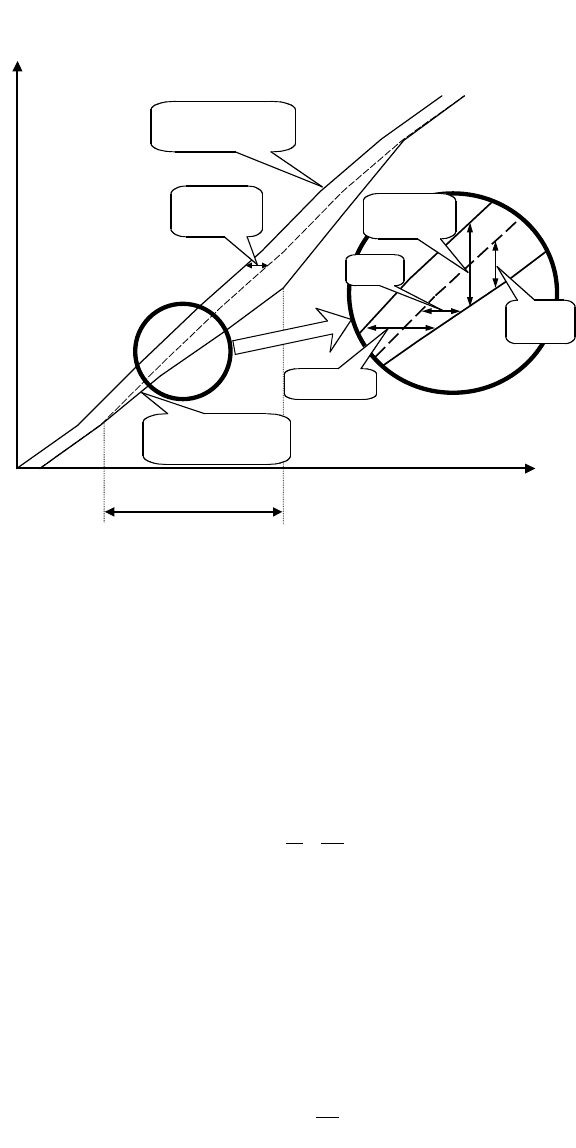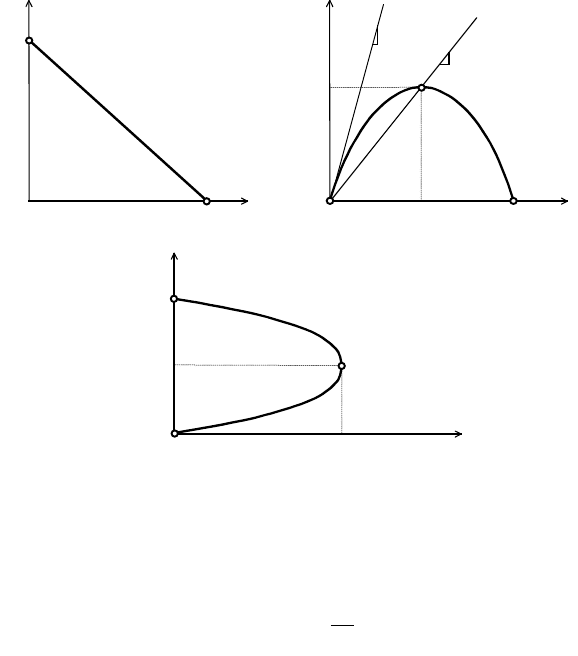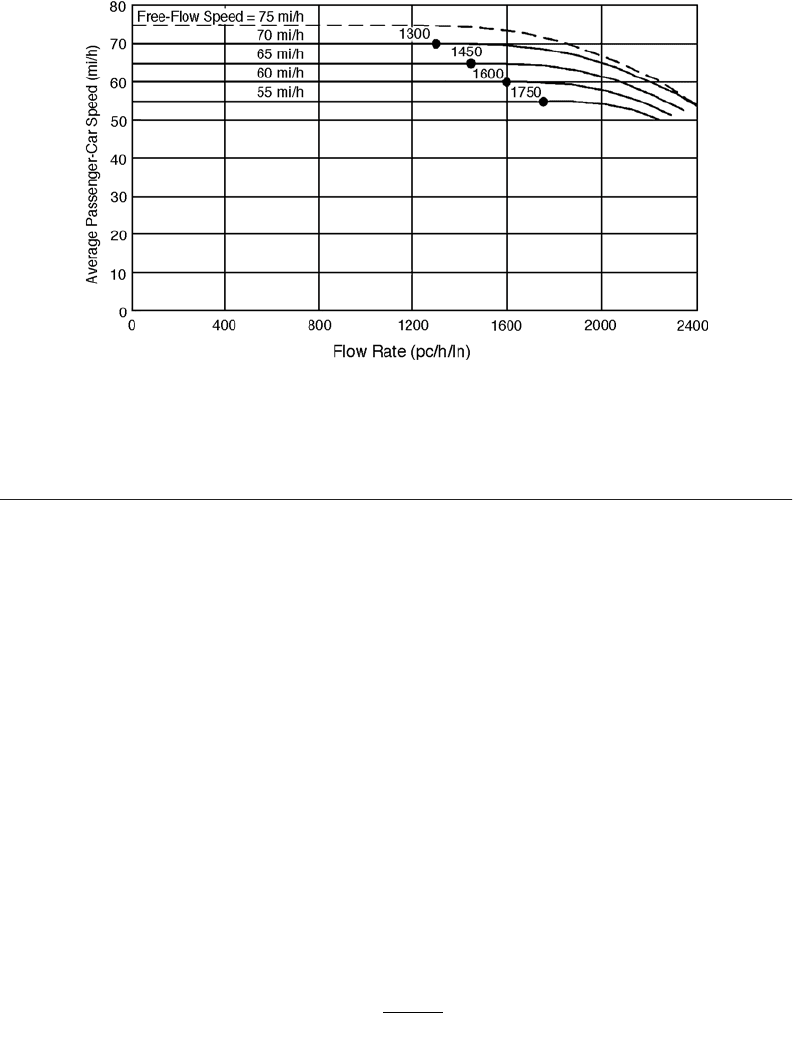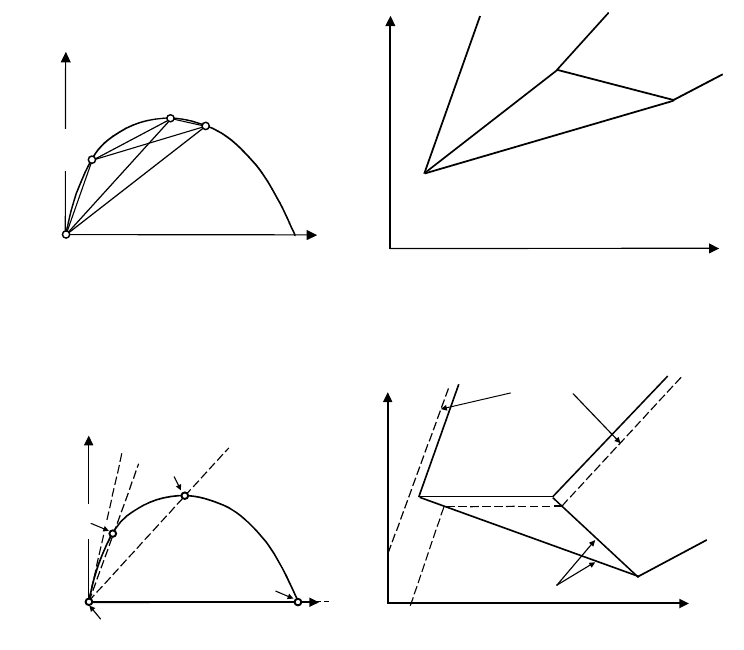Wai-Fah Chen.The Civil Engineering Handbook
Подождите немного. Документ загружается.


Highway Traffic Operations
64
-3
where
D
is measured in vehicles per mile per one lane,
L
is the length of the segment expressed in miles,
and
n
is the number of traffic lanes. Typically, density is measured in each direction separately. The speeds
of vehicles at the moment of measurement can be averaged to calculate the so-called
space-mean speed S
L
:
(64.2)
where
S
L
= calculated based on
N
instantaneous observations
S
i
= the speed of vehicle
i
on the highway segment
Spot observations render the number of vehicles passing a spot during an observation period. This
count can be converted to
traffic volume
V
:
(64.3)
where
V
is the volume typically expressed in vehicles per hour, estimated based on the count
N
observed
for period
T
(in hours). The speeds of vehicles are sometimes measured in spot observations, and the
average speed, called
time-mean speed
, is calculated as follows:
(64.4)
where
S
T
is the time-mean speed calculated based on
N
spot measurements and
S
i
is the speed of vehicle
i
included in the observation. The time-mean and space-mean speeds measured for the same traffic are
typically not equal. This phenomenon will be explained later in this chapter.
Spot observations must be planned in accordance with the time of day, week, and year that are to be
represented by the measurements. Due to the considerable random and periodic variability of traffic, the
observation period must be adequate for the purpose. Traffic observations in short intervals may vary
randomly; thus a short observation period of seconds or minutes is not recommended to represent an
entire hour. On the other hand, traffic fluctuations over the period of an entire day make a several-hour
traffic observation nonrepresentative for any particular hour within the observation period as well as for
the entire day. It is prudent to observe traffic for 1 hour to obtain hourly traffic estimates and for 1 day
for daily traffic estimates. Of course, if the periodic fluctuation is known, then even hourly observations
can be converted to daily observations by using appropriate conversion factors.
The Manual of Traffic
Engineering Studies
(Robertson et al., 1994) and McShane et al. (1998) provide more information on
traffic variability, adequate observation periods, and various traffic studies.
Fundamental Traffic Flow Relationship
Let us assume that all vehicles move at the same speed
S
. The time headway between two consecutive
vehicles
h
is the distance
x
between these two vehicles divided by speed
S
:
h
=
x
/
S
. If someone measures
the time headways and the distances between consecutive vehicles and calculates the average values
–
h
and
–
x
, the relationship between the average values will be preserved:
–
h
=
–
x
/
S
. It is also true that 1/
–
h
=
S
/
–
x
.
Please notice that the reverse of average intervehicle time is volume
V
and that the reverse of average
intervehicle distance is density
D
. Thus, we can write
(64.5)
Now, let us assume that a traffic flow consists of
k
classes of vehicles. All vehicles of class
i
move at
speed
S
i
. If
V
i
is the volume of
i
-class vehicles and
k
i
is the density of
i
-class vehicles, then we can claim
that
V
i
=
S
i
·
D
i
. Since the total volume is
S
N
S
Li
i
N
=
=
Â
1
1
V
N
T
=
S
N
S
Ti
i
N
=
=
Â
1
1
VSD= ◊
© 2003 by CRC Press LLC

64
-4
The Civil Engineering Handbook, Second Edition
and the total density is
we can say that
Since
is the space-mean speed
S
L
(densities are obtained in instantaneous observations), it is proven that
(64.6)
This relationship is called the fundamental traffic flow relationship.
Estimating Space-Mean Speed and Traffic Density from Spot Observations
The source of discrepancy between the time-mean and space-mean speeds can be demonstrated by
considering a segment of highway with two classes of vehicles: slow and fast (Fig. 64.2 and Table 64.1).
The difference between the two speeds is caused by the higher fraction of fast vehicles in total volume
than in total density. Although the difference in the two speeds is negligible in typical traffic conditions,
it may be considerable in a particular situation, such as when some vehicles are stopped. Zero speeds
significantly reduce the average space-mean speed, but they are not included in the time-mean speed,
since the volume of the vehicles with zero speed is zero.
Spot observations render speeds of vehicles that pass a particular spot. Straight averaging gives the
time-mean speed. To estimate the space-mean speed, let us first consider vehicles having the same speed.
Let
N
i
be a count of vehicles with speed
S
i
. The corresponding volume can be estimated as
V
i
= N
i
/T.
FIGURE 64.2 Example of a highway section for speeds comparison.
VV
i
i
k
=
=
Â
1
DD
i
i
k
=
=
Â
1
VSDDS
D
D
ii
i
k
i
i
k
i
= ◊ =
==
ÂÂ
11
S
D
D
i
i
k
i
=
Â
1
VSD
L
= ◊
0.25 mi
Slow vehicle, S
1
= 50 mi/h
Fast vehicle, S
2
= 70 mi/h
© 2003 by CRC Press LLC

Highway Traffic Operations 64-5
Using the relationship derived for flows with the same speed, V
i
= S
i
D
i
, we can claim that D
i
= V
i
/S
i
or
D
i
= N
i
/(S
i
·T). Since the space-mean speed is
we can say that
Since T and some speeds S
i
cancel out, the formula becomes
The result will not change if each vehicle constitutes its own class, even if some other vehicles have
the same speed. The final formula is
(64.7)
The density near the spot can be estimated using the fundamental traffic flow equation, D = V/S
L
=
(N/T)/S
L
, or, after using Eq. (64.7),
TABLE 64.1 Comparison of the Space-Mean and Time-Mean Speeds
Va riable Equation Calculation
Space-Mean Speed
Density of slow vehicles D1 = N
1
/L 4/0.25 = 16 veh./mi.
Density of fast vehicles D2 = N
2
/L 6/0.25/2 = 24 veh./mi.
Total density D 16 + 24 = 40 veh./mi.
Fraction of slow vehicles on segment D
1
/D 8/20 = 0.40
Fraction of fast vehicles on segment D
2
/D 12/20 = 0.60
Space-mean speed on segment S
1
·D
1
/D + S
2
·D
2
/D 50(0.40) + 70(0.60) = 62.0 mi./hr
Time-Mean Speed
Vo lume of slow vehicles V
1
= S
1
·D
1
50 _ 16 = 800 veh./hr
Vo lume of fast vehicles V
2
= S
2
·D
2
70 _ 24 = 1680 veh./hr
Total volume V = V
1
+ V
2
800 +1680 = 2480 veh./hr
Fraction of slow vehicles in volume V
1
/V 800/2480 = 0.323
Fraction of fast vehicles in volume V
2
/V 0.677
Time-mean speed at spot on segment S
T
= S
1
·V
1
/V + S
2
·V
2
/V 50(0.323) + 70(0.677) = 63.5 mi./hr
Note: veh. = vehicle.
S
D
SD
Lii
i
k
=
=
Â
1
1
S
SN ST
NST
L
iii
i
k
ij
j
k
=
◊
()
()
=
=
Â
Â
1
1
S
N
NS
N
NS
L
i
i
k
ij
j
k
ij
j
k
==
=
==
Â
ÂÂ
1
11
S
N
S
L
j
j
N
=
=
Â
1
1
© 2003 by CRC Press LLC

64-6 The Civil Engineering Handbook, Second Edition
(64.8)
Please notice that spot observations may not include vehicles with zero speeds.
64.3 Measuring Techniques
Instantaneous Observations
An instantaneous observation requires an observer to be at a sufficient elevation to see all vehicles on an
observed highway segment. A tall building located near the highway segment is the least expensive
solution. However, in many cases tall buildings are not available, so aerial photography is used. An
equipped aircraft takes two photographs in short succession and the vehicle speeds are estimated from
their shifts along the highway segment. Instantaneous observations are expensive and are not often used.
As has been shown, spot observations may be used to estimate space-mean speed and density.
Spot Observations
In manual techniques, human observers count and classify vehicles and sometimes measure their speeds.
This technique is accurate but expensive. Machine measurements are less expensive, and numerous tech-
niques and technologies are available. This section briefly overviews several commonly used alternatives.
Vehicles are detected by devices called detectors, which utilize various physical phenomena such as
perturbation of electromagnetic or magnetic fields, changes of pressure in rubbers tubes, generation of
electrical field in piezoelectric materials, detection of energy reflected or generated by a vehicle, and the
Doppler phenomenon caused by a vehicle. The types of energy used in vehicle detection include almost
all ranges of electromagnetic and acoustic waves. The most popular detectors are electromagnetic loops
installed in the pavement, and video detectors that use the visible range of electromagnetic waves are
becoming popular.
Regardless of the detection technology used, the most popular technique is based on a detection zone,
which is the spot on the pavement selected when setting a detector. Some detectors count only vehicles,
while others measure the time vehicles are present in the detection zone. Most detectors can use more
than one detection zone. The dimensions of detection zones vary from very small (microsensors) to large
enough to span across several lanes and over a long distance. The detection zone dimensions depend on
the type of detector and its purpose. If traffic measurements are the purpose, the detection zone should
be small. A traditional detection zone is a 6-foot-long square or hexagon that covers a single traffic lane.
Let us first consider a detector that uses a single detection zone and is able to measure the time when
vehicles are present in the detection zone. Figure 64.3 presents two vehicles passing the detection zone,
represented by two trajectories: the front bumpers and the rear bumpers. The presented detector is
capable of returning counts and vehicle presence information. Typical detectors calculate so-called detec-
tor occupancy, which is the percent of time when the detection zone was occupied by vehicles. If an
observation period is 5 minutes, 20% detector occupancy means that for a total time of 1 minute during
the observation period one or more vehicles were present in the detection zone. Typically, detectors
return data in consecutive intervals. Volume V is calculated with Eq. (64.3). The following equations
calculate space-mean speed S
L
and density D from count N and detector occupancy B, obtained for an
interval of length T:
(64.9)
(64.10)
D
TS
j
j
N
=
=
Â
11
1
S
Nl l
TB
L
vd
=
◊◊ +
()
◊
100
D
B
ll
vd
=
◊ +
()
100
© 2003 by CRC Press LLC

Highway Traffic Operations 64-7
where l
v
stands for vehicle length and l
d
stands for detection zone length. These lengths should be in miles
and T should be in hours to obtain speed in miles/hour and density in vehicles/mile/lane. Detector occu-
pancy B is expressed in percent. Equation (64.9) can be derived by starting with individual vehicle speeds
S
i
= (l
vi
+ l
d
)/t
i
, where l
vi
is the length of vehicle i and t
i
is the detector occupancy time caused by vehicle i.
Equation (64.7), used together with the definition of detector occupancy, yields Eq. (64.9). Equation (64.10)
is obtained from Eq. (64.9) by using the fundamental flow relationship shown in Eq. (64.6).
The main disadvantage of single detection zones is that the vehicle length is not measured and therefore
has to be assumed. Detectors with a single detection zone are used mainly to count vehicles and to
evaluate the congestion level through detector occupancy — a quantity directly related to traffic density,
as seen in Eq. (64.10).
Detectors with two detection zones are much more reliable in measuring vehicle speeds. The known
distance between the leading edges of two detection zones divided by the travel time between the two
edges estimates the speed of a vehicle. The vehicle length is estimated from its speed and the time it
occupies the detection zone. This information is used to classify vehicles.
Cumulative Counts
A new technique based on cumulative counts at spots was proposed for freeway traffic by Cassidy and
Windover (1995), using count detectors located along a freeway section at a frequency of approximately
1/2 mile. Detectors are required in all traffic lanes, and vehicle counting starts as the same vehicle passes
the consecutive spots. Cumulative counts over an extended period can be used to estimate the number
of vehicles present between two spots (segment occupancy), travel times between two spots, vertical
queues, and delays (see Fig. 64.4).
64.4 Relationships between Volume, Speed, and Density
Traffic flow characteristics — volume, speed, and density — do not vary independently from one another.
The fundamental traffic flow equation ties these three characteristics together and allows for calculating
the quantity of one of them when the other two are known. The fundamental equation was derived from
the basic properties of traffic flows without any assumptions about driver behavior. An additional
equation is needed in order to calculate two unknown flow characteristics from one known.
FIGURE 64.3 Measurements with a single detector.
off
n
t
off
n
t
on
n
+1
t
off
n
+1
t
Distance
Time
occ
n
t
occ
n
+1
t
l
v
d
Trajectory of
n
-vehicle’s
front
Trajectory of
n
-vehicle’s
rear
© 2003 by CRC Press LLC

64-8 The Civil Engineering Handbook, Second Edition
Theories
Multiple theories furnish a second equation derived from assumptions about how drivers respond to
traffic situations or by assuming analogies between traffic and flows (Gartner et al., 1995). For example,
Pipes (1953) postulates a linear relationship between the speed and the distance between vehicles. If one
assumes also that drivers are identical and consistent, that they do not pass other vehicles, and that
particular traffic conditions exist long enough for drivers to adjust their speeds, the following speed–density
relationship can be derived:
(64.11)
The speed of vehicle flow S depends on maximum volume V
M
, traffic density D, and maximum density
D
J
, called the jam density. Equation (64.11) inherits the weakness of the crude assumptions about driver
behavior. The attempt to apply this equation to low-density conditions fails, since the speed prediction
is unrealistically high.
Among other theories, one that is considered reasonable for all traffic conditions is called Greenshields’
equation (Greenshields, 1935). It assumes that drivers adjust their speed to the speed of preceding vehicles,
but unlike Eq. (64.11), this response weakens with the square distance between vehicles. The equation is
(64.12)
The theory says that vehicles move at their maximum speed, called free-flow speed S
F
, when the
highway is empty (D = 0), and the speed drops linearly with an increase in density and reaches zero at
FIGURE 64.4 Measurements with cumulative counts.
Period with
reduced capacity
Time
Cumulative
Number of
Vehicles
Travel time
Delay
Segment
occupancy
Vertical
queue
Free-flow
travel time
Cumulative counts
at the first spot
Cumulative counts
at the second spot
SV
DD
M
J
=-
Ê
Ë
Á
ˆ
¯
˜
11
SS
D
D
F
J
= ◊ -
Ê
Ë
Á
ˆ
¯
˜
1
© 2003 by CRC Press LLC

Highway Traffic Operations 64-9
jam density D
J
. The relationship between volume and density is a parabolic curve obtained after using
Eq. (64.5) for a flow of vehicles with identical speeds:
(64.13)
Figure 64.5 shows three relationships between volume, speed, and density derived from both the
Greenshields’ and fundamental traffic flow equations. These relationships indicate the existence of traffic
conditions with maximum flow C. This value is considered the capacity of the segment, with traffic
characterized by the curves. Also, free-flow and jam conditions are shown on these graphs.
Recent observations of freeway traffic and simplifications in traffic modeling have led to a piecewise
linear relationship between volume and density (Daganzo, 1992; Newell, 1993): V = min {S
F
·D, V
M
·(1 –
D/D
J
)}. Surprisingly, this relationship can be easily obtained from Eq. (64.11) by using free-flow speed
S
F
as an upper bound for speed S and then applying the fundamental relationship in Eq. (64.5).
Greenshields’ equation and others are quite useful in understanding the effect of driver behavior on
traffic conditions. One plausible result is that drivers tend to slow down when density increases; another
is that capacity is reached at a particular density value. If density grows beyond the capacity, the loss in
volume caused by the speed decrease exceeds the gain caused by the density increase, and the volume
drops. Capacity is determined by the spacing drivers maintain between vehicles. Drivers select spacing
perceived as safe for the speed that persists in the capacity conditions. The second half of the volume–den-
sity curve and the bottom half of the speed–volume curve describe traffic forced to move slower by some
flow constraint located downstream. Drivers slow down accordingly and reduce their distances between
vehicles. Jam density indicates the distance drivers prefer between vehicles when stopped in a queue. A
comprehensive overview of flow relationships can be found in May (1990) and Gardner et al. (1995).
Field Observations
The presented traffic flow relationships were derived from assumptions that fall short of the true complexity
of traffic. Drivers are not identical; they drive different vehicles, change lanes, and behave inconsistently.
FIGURE 64.5 Greenshields’ traffic flow relationships.
Speed
S
Density
k
Volume
V
D
Speed
S
Volume
V
S
F
C
=
S
F
·
D
J
/
4
D
J
D
C
=
D
J
/
2
D
J
S
C
=
S
F
/
2
C
S
F
S
C
S
F
VDS
D
D
F
J
= ◊◊-
Ê
Ë
Á
ˆ
¯
˜
1
© 2003 by CRC Press LLC

64-10 The Civil Engineering Handbook, Second Edition
It should not be a surprise that the trends in field observations do not fully follow theories. Figure 64.6
presents example results of spot observations (Banks, 1989). One striking departure from the Green-
shields’ model is the small speed reduction for quite a wide range of volumes, which is caused mainly
by the opportunity for passing on multilane highways. As long as passing is possible, drivers maintain
their preferred speeds, and the average flow speeds do not indicate any effect of growing volume or
density. Speed declines noticeably when traffic volume approaches capacity.
Other departures from the existing traffic flow theories are two values of capacity reported by Hall and
Agyemang-Duah (1991). It seems that traffic moving smoothly for a while can reach quite high values,
which indicates that drivers accept short distances between vehicles. On the other hand, when traffic
discharges from a standing queue, its volume does not reach the capacity observed for moving flows.
As mentioned earlier, so-called forced traffic is observed where the density of traffic is larger than the
density value in capacity conditions. Dense traffic is caused by a downstream obstruction, which is called
bottleneck, the effects of which are apparent when traffic volumes without a bottleneck would be higher
than the bottleneck capacity. Bottlenecks are caused by a reduced number of lanes, activities that distract
drivers, or traffic controls such as stop signs and traffic signals.
Measurements representing capacity and near-capacity conditions are more scattered than those rep-
resenting other conditions. These measurement points, lying mostly inside the expected speed–volume
curve, represent transient conditions where traffic is changing from free-flowing to forced or from forced
to free-flowing. Flows in transient conditions consist of drivers who rapidly change speeds to adjust to
new conditions. Because the flow relationships discussed here represent conditions in which drivers have
already reached their preferred speeds and spacing, transient conditions are not well described with these
relationships.
The widely used Highway Capacity Manual (HCM) contains methods of predicting the capacity of
highway segments and bottlenecks and their impacts on traffic conditions (Transportation Research
Board, 2000). The chapter on freeway segments uses speed–volume relationships generalized from field
observations (Fig. 64.7). These curves apply to specific conditions, called ideal. The HCM provides a
means to convert the actual traffic volume in actual conditions to its equivalent value under ideal
conditions. The speed–volume and fundamental relationships allow for the calculating of the speed and
density from known traffic volume persisting on an analyzed freeway segment. It should be mentioned
that the bottom part of the curve for congested and forced traffic is not shown, since the HCM focuses
on conditions that are acceptable to motorists. Further details on highway capacity are presented in
Section 64.6.
FIGURE 64.6 Example detector observations. (From Banks, J.H., Transp. Res. Rec., 1225, 53, 1989.)
© 2003 by CRC Press LLC

Highway Traffic Operations 64-11
64.5 Queues and Delays at Bottlenecks
Points on the earlier introduced flow relationship curves represent traffic conditions ranging from free-
flow to jam. The points represent a stable situation when drivers’ speeds and distances have already been
adjusted and these conditions are called steady state. The HCM methods for freeways and other types
of road segments apply to steady-state traffic that persists during the busiest 15 minutes of design or
rush hour. This is acceptable for uniform road sections without bottlenecks, since actual 15-minute traffic
measurements indeed can be approximately steady. A single steady state cannot properly represent
highway operations where traffic conditions change rapidly. Such changes are observed upstream of a
highway bottleneck, where the congested traffic of vehicles in the queue meets the noncongested traffic
of arriving vehicles.
Shock Waves
The boundary between congested and noncongested traffic where vehicles slow down rapidly is called a
shock wave. A shock wave is also created by vehicles that accelerate rapidly after being released from a
queue, for example, during a green signal. A shock wave can travel forward or backward. The end of a
growing queue moves backward while the end of a dense column of vehicles behind a truck can move
forward.
Speed w of a shock wave depends on the characteristics of traffic states that meet each other at the
shock wave location:
(64.14)
A truck blocking traffic is the example presented in Fig. 64.8. The truck’s speed is lower than the flow
speed in capacity conditions and passing is not possible. The straight sections on the volume–density
curve connect points represent distinct traffic states. The slopes of these sections equal the corresponding
shock waves separating the two traffic states (Eq. (64.14)). The solid lines on the time-space diagram are
the shock waves’ trajectories separating different traffic states. The time-space areas bounded by the shock
waves’ trajectories are arriving traffic, behind-truck traffic, free-flow traffic in front of the truck, and
FIGURE 64.7 Speed–volume relationships for ideal conditions. (From Transportation Research Board, Highway
Capacity Manual, Special Report 209, National Research Council, Washington, D.C., 2000.)
w
VV
DD
=
-
-
12
12
© 2003 by CRC Press LLC

64-12 The Civil Engineering Handbook, Second Edition
capacity conditions. The only backward shock wave is the shock wave of accelerations that separates the
capacity conditions from the behind-truck conditions. The capacity conditions appear after the truck
exits the road and when vehicles at the front of the dense column accelerate to reach the speed and the
spacing between vehicles desired for the capacity conditions.
When the truck’s speed is lower than the speed of unaffected vehicles and is higher than the capacity
speed, vehicles decelerate when joining the traffic behind the truck and accelerate back to the original
speed after being released in the front of the column. The wave of accelerations is forward. Capacity state
does not occur since its appearance would require vehicles released from the front of the column to
decelerate to reach the capacity speed, which is against the tendency of drivers to travel at their desired
speeds if possible. More about the theory of shock waves can be found in Lighthill and Whitham (1955),
Richards (1955), Gartner et al. (1995), and in most textbooks on traffic flow theory.
A slow-moving truck can be viewed as a moving bottleneck, while a jam caused by immobile obstruc-
tions, such as traffic signals or temporary road closures, is called a stationary bottleneck. Traffic directly
upstream of an obstruction does not move and accumulates in a queue at jam density. When the
obstruction ends, the traffic released in the front of the queue accelerates and reaches capacity state
because the zero speed of traffic behind the obstruction is apparently lower than the capacity speed.
Figure 64.9 presents all the traffic states and shock waves associated with a temporary obstruction.
The dimensions of the triangle with jam conditions can be calculated using Eq. (64.14) and other
equations. The triangle’s side parallel to the time axis is equal to the interruption time t
I
, while the slope of
the triangle’s side representing the wave of decelerations (boundary between unaffected and jam traffic) is
FIGURE 64.8 Shock waves caused by a slow vehicle.
FIGURE 64.9 Shock waves caused by traffic interruption.
Flow
Density
Distance
Time
Behind-truck
traffic
Capacity
traffic
Free-flow
traffic
Behind-truck
traffic
Unaffected
traffic
Free-flow
traffic
Capacity traffic
Unaffected
traffic
Flow
Density
Distance
Time
Unaffected
traffic
Capacity
traffic
Traffic
jam
Free-flow
traffic
Capacity
traffic
Unaffected
traffic
Traffic
jam
Free-flow
traffic
Trajectories
of vehicles
Trajectories
of shock
waves
© 2003 by CRC Press LLC
